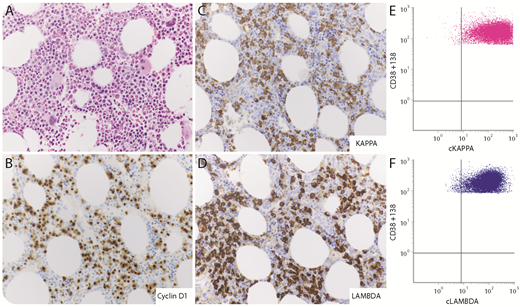A 69-year-old man with a history of chronic renal failure was evaluated for plasma cell neoplasm and was found to have elevated serum free λ (2845 mg/L; normal, 5-26 mg/L) and κ (127 mg/L; normal, 3-19 mg/L) light chains with a free κ:λ ratio of 0.04 (normal, 0.3-1.7). He had heavy proteinuria (2904 mg/24 hours), and monoclonal free λ light chain was detected by urine immunofixation electrophoresis. No osteolytic lesions or lymphadenopathy were detected by imaging studies. The bone marrow biopsy showed increased plasma cells that made up 30% of the marrow cellularity (panel A, original magnification ×400). They were positive for CD138, cyclin D1 (panel B, original magnification ×400), kappa (κ) (panel C, original magnification ×400), and lambda (λ) (panel D, original magnification ×400) immunohistochemical stains. Aberrant plasma cells with the CD45–, CD38+, CD138+, CD56+/partial, CD117+/partial, CD19+/dim, CD20+/partial immunophenotype were detected by flow cytometry. They were expressing cytoplasmic κ and λ light chains (panels E and F; cKAPPA, cytoplasmic κ light chain; cLAMBDA, cytoplasmic λ light chain). Fluorescence in situ hybridization analysis demonstrated CCND1-IGH rearrangement. The diagnosis of biphenotypic multiple myeloma was rendered.
We present a very rare case of biphenotypic plasma cell myeloma in which the same neoplastic plasma cells expressed cytoplasmic κ and λ light chains with secretion of predominantly free λ light chain. The formation of biphenotypic myeloma could be explained by mutations in the light chain gene because it causes failure in allelic exclusion machinery.
A 69-year-old man with a history of chronic renal failure was evaluated for plasma cell neoplasm and was found to have elevated serum free λ (2845 mg/L; normal, 5-26 mg/L) and κ (127 mg/L; normal, 3-19 mg/L) light chains with a free κ:λ ratio of 0.04 (normal, 0.3-1.7). He had heavy proteinuria (2904 mg/24 hours), and monoclonal free λ light chain was detected by urine immunofixation electrophoresis. No osteolytic lesions or lymphadenopathy were detected by imaging studies. The bone marrow biopsy showed increased plasma cells that made up 30% of the marrow cellularity (panel A, original magnification ×400). They were positive for CD138, cyclin D1 (panel B, original magnification ×400), kappa (κ) (panel C, original magnification ×400), and lambda (λ) (panel D, original magnification ×400) immunohistochemical stains. Aberrant plasma cells with the CD45–, CD38+, CD138+, CD56+/partial, CD117+/partial, CD19+/dim, CD20+/partial immunophenotype were detected by flow cytometry. They were expressing cytoplasmic κ and λ light chains (panels E and F; cKAPPA, cytoplasmic κ light chain; cLAMBDA, cytoplasmic λ light chain). Fluorescence in situ hybridization analysis demonstrated CCND1-IGH rearrangement. The diagnosis of biphenotypic multiple myeloma was rendered.
We present a very rare case of biphenotypic plasma cell myeloma in which the same neoplastic plasma cells expressed cytoplasmic κ and λ light chains with secretion of predominantly free λ light chain. The formation of biphenotypic myeloma could be explained by mutations in the light chain gene because it causes failure in allelic exclusion machinery.
For additional images, visit the ASH Image Bank, a reference and teaching tool that is continually updated with new atlas and case study images. For more information, visit http://imagebank.hematology.org.


This feature is available to Subscribers Only
Sign In or Create an Account Close Modal